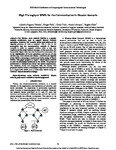High Throughput WMN for the Communication in Disaster Scenario
| dc.contributor.author | Tchinda, AP | |
| dc.contributor.author | Frick, G | |
| dc.contributor.author | Trick, U | |
| dc.contributor.author | Lehmann, A | |
| dc.contributor.author | Ghita, B | |
| dc.date.accessioned | 2021-05-18T11:56:31Z | |
| dc.date.available | 2021-05-18T11:56:31Z | |
| dc.date.issued | 2020-05 | |
| dc.identifier.isbn | 9781728197388 | |
| dc.identifier.uri | http://hdl.handle.net/10026.1/17136 | |
| dc.description.abstract |
The Wireless mesh network (WMN) is a popular network architecture used to support disaster recovery operations. However, few research works have addressed the capacity problem of such a network. This is due to the assumption that the communication network in disaster scenario is built to support services with a low rate requirement like delay tolerant messages. At the same time, the demand for higher data rates has increased in recent years due to the digitalisation of rescue operations and the use of new services (e.g. VoIP, drones and robots). Therefore, the capacity of the WMN is becoming a central issue in the design of future WMNs. This paper proposes a Layer 1 cluster-based network to solve the throughput bottleneck in the WMN. The proposed architecture is evaluated by several real world measurements. The obtained results are compared with the theory. The proposed solution shows a throughput improvement compared to a single-radio WMN and a multi-radio WMN using the CoMTaC channel allocation strategy. | |
| dc.format.extent | 53-63 | |
| dc.language.iso | en | |
| dc.publisher | IEEE | |
| dc.title | High Throughput WMN for the Communication in Disaster Scenario | |
| dc.type | conference | |
| dc.type | Conference Proceeding | |
| plymouth.date-start | 2020-05-13 | |
| plymouth.date-finish | 2020-05-15 | |
| plymouth.volume | 00 | |
| plymouth.conference-name | 2020 World Conference on Computing and Communication Technologies (WCCCT) | |
| plymouth.publication-status | Published | |
| plymouth.journal | 2020 World Conference on Computing and Communication Technologies (WCCCT) | |
| dc.identifier.doi | 10.1109/wccct49810.2020.9170007 | |
| plymouth.organisational-group | /Plymouth | |
| plymouth.organisational-group | /Plymouth/Faculty of Science and Engineering | |
| plymouth.organisational-group | /Plymouth/REF 2021 Researchers by UoA | |
| plymouth.organisational-group | /Plymouth/REF 2021 Researchers by UoA/UoA11 Computer Science and Informatics | |
| plymouth.organisational-group | /Plymouth/Users by role | |
| plymouth.organisational-group | /Plymouth/Users by role/Academics | |
| dc.rights.embargoperiod | Not known | |
| rioxxterms.versionofrecord | 10.1109/wccct49810.2020.9170007 | |
| rioxxterms.licenseref.uri | http://www.rioxx.net/licenses/all-rights-reserved | |
| rioxxterms.type | Conference Paper/Proceeding/Abstract |


